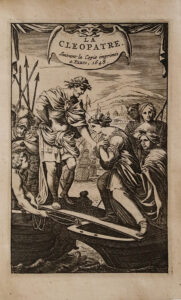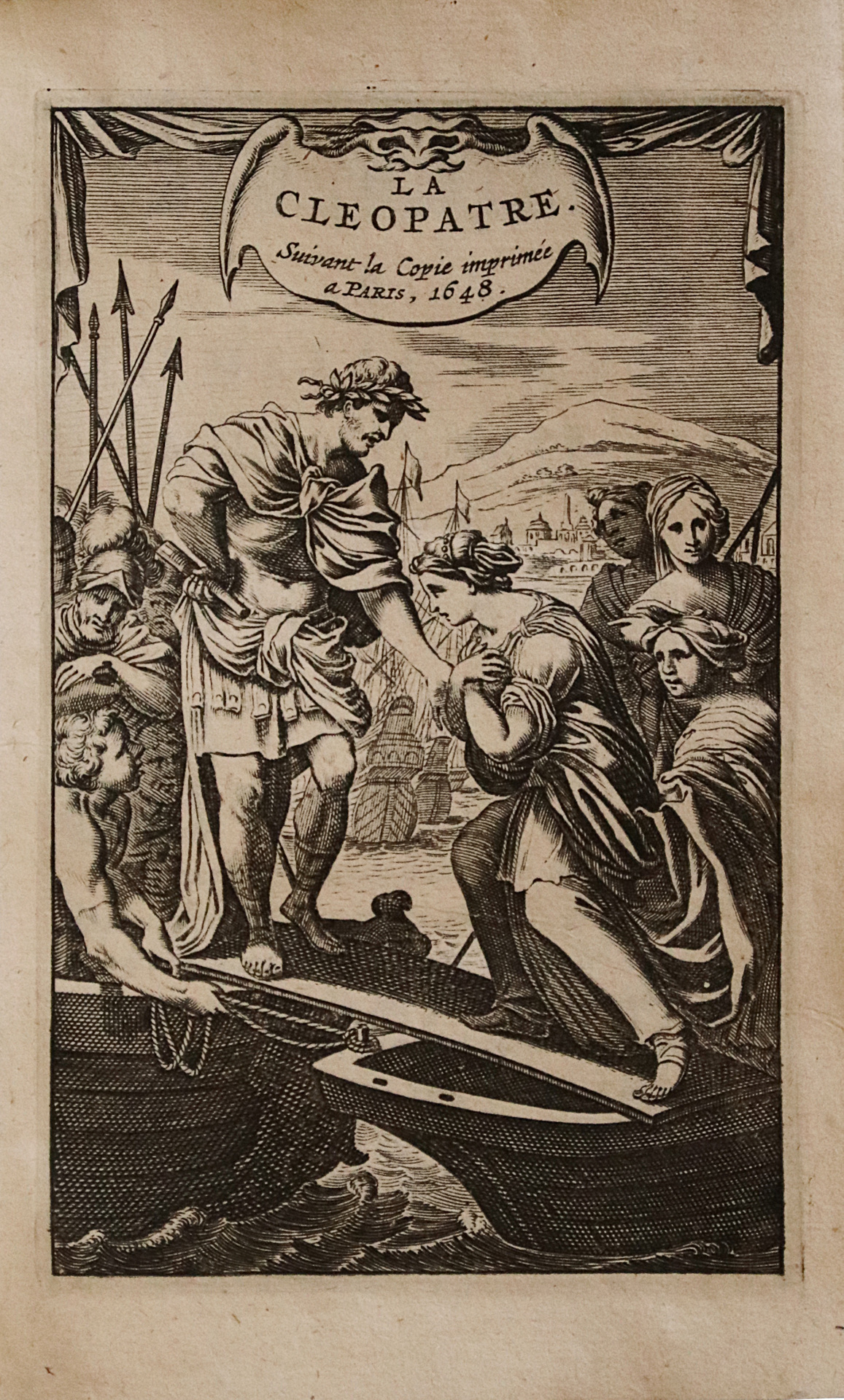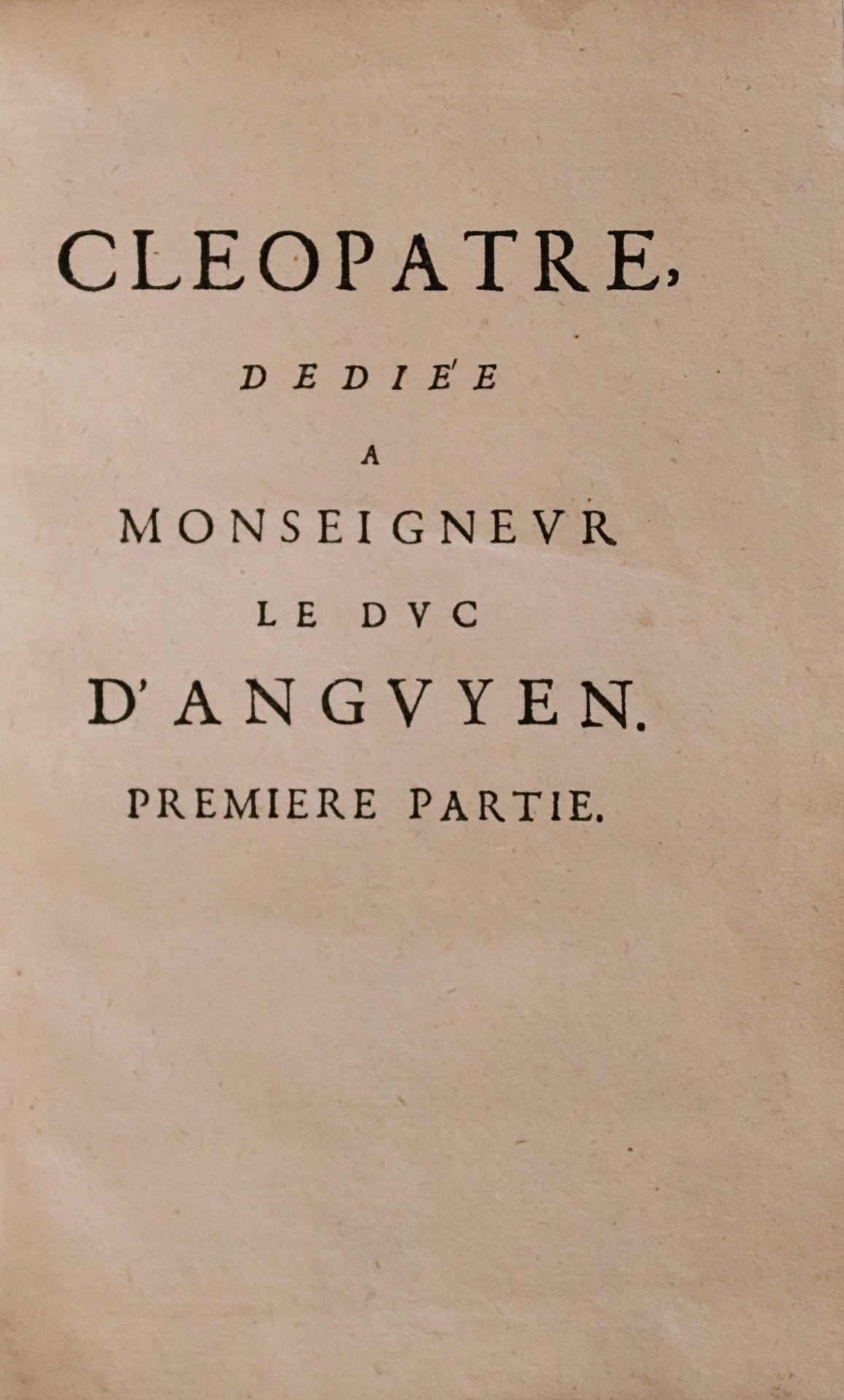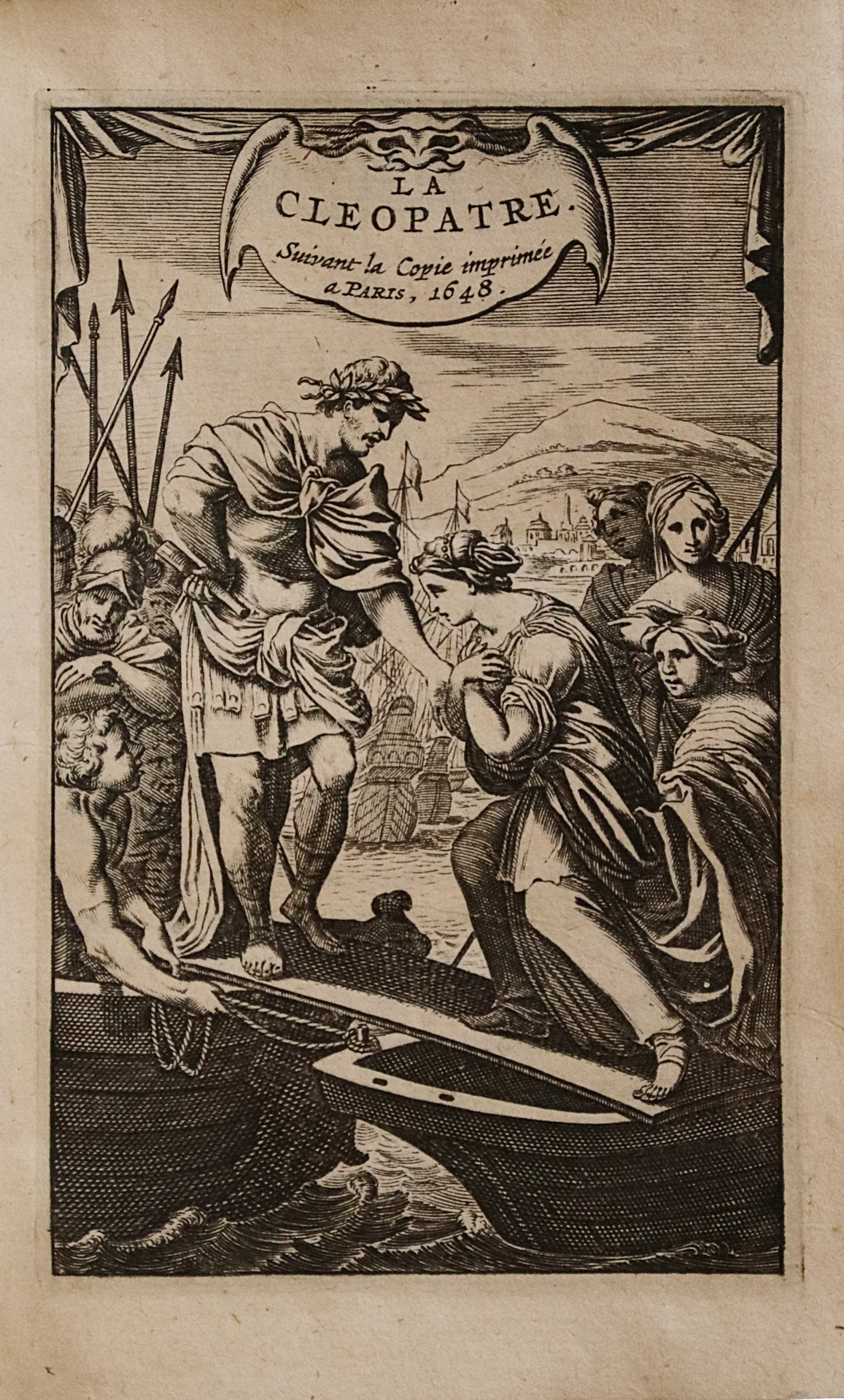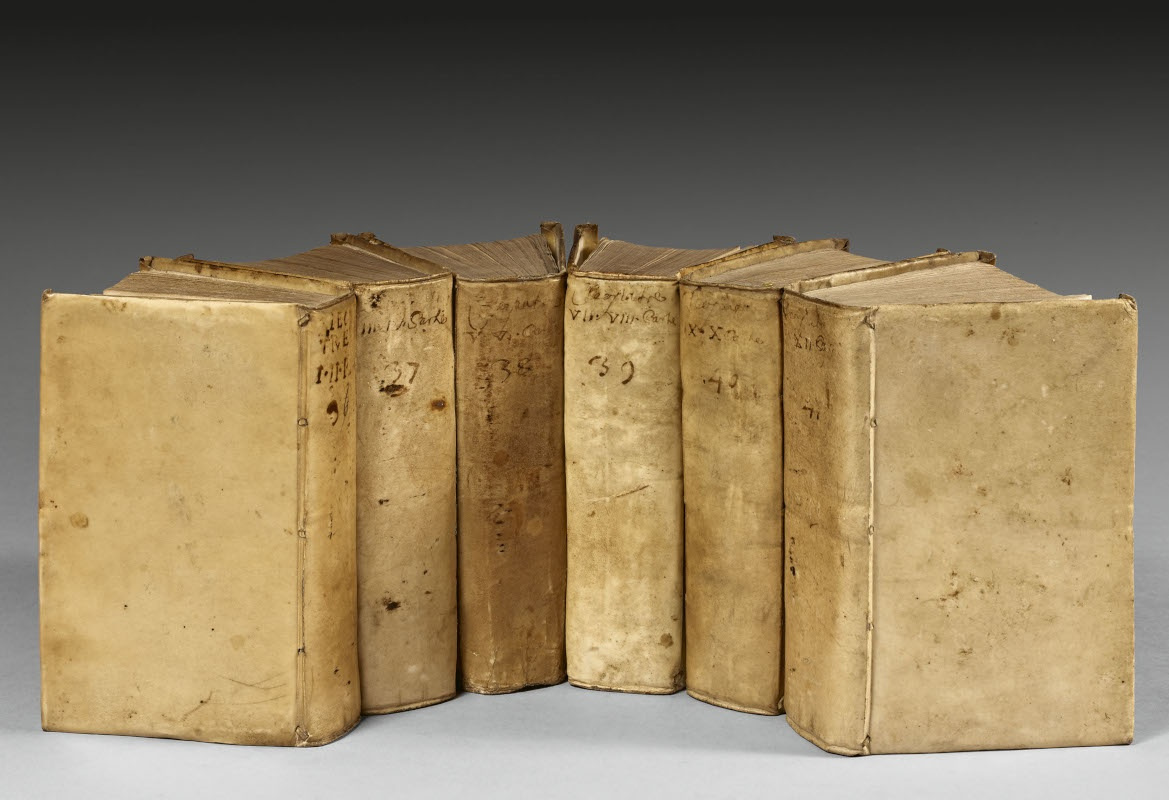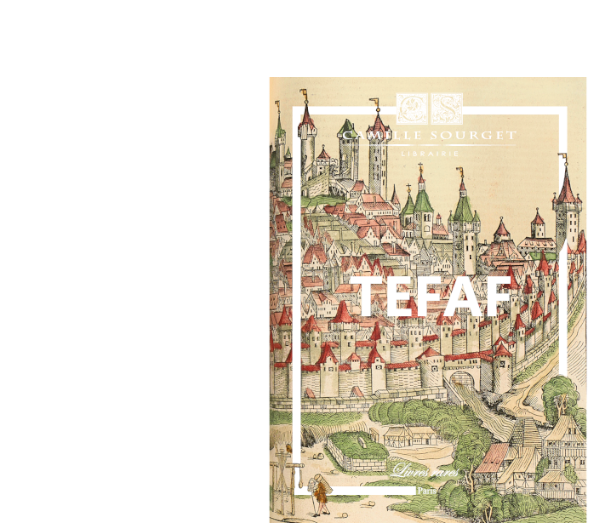Suivant la copie imprimée à Paris, 1648. Paris, Leyde, Jên Sambix, 1654-1653-1654-1654-1649-1653-1653-1657-1657-1658-1658.
A total of 12 parts bound in 6 volumes 12mo [154 x 94] of: 304 pp., including a frontispiece, 312 pp., 352 pp. (small worm track in the margin of pp. 43 to 75 and 159 to 171), 368 pp., 336 p., 352 pp., 380 pp., (2) bl. ll., 360 pp., 336 pp., 315 pp., 352 pp. (wrongly numbered 362), 376 pp. Stiff overlapping vellum, flat spines. Contemporary binding.
One of the two reference editions, exceedingly rare complete, described by the bibliographers, mentioned by Brunet as « the most attractive of the two », of Cleopatra, the masterpiece of La Calprenède, (1610‑1663), « one of the grêt novelists of the French language of the 17th century ». (E. Seillière)
Two first editions emerge at that time, one of them, the first edition, was printed in Paris in 12 volumes small 8vo between 1646 and 1657.
Tchemerzine writes (III, p. 828): « We were not able to find a homogenous copy of this novel famous at its time. The French National Library owns a copy of the first part [1646], (out of 12), which title is missing. »
The other one, printed in the same way in 12 volumes 8vo by Bonaventure and Abraham Elsevier –1648-1658 – just as rare is, according to Brunet, « more attractive » but the rare complete copies are just as composite.
For these two first editions, the number of lêves of text and of title varies according to the copies (see on this topic the description of the Sorbonne and of the Versailles Library given by Tchemerzine). Each of the twelve parts of our copy contemporary bound is complete with its text and its twelve title-pages. Copies complete like so are extremely rare.
Gautier de Costes, seigneur of La Calprenède, married in 1646 a “précieuse” rather known at the time, Madeleine de Lyée, on whom Tallemant de Réaux tells horrifying stories and who made him extremely unhappy until their brêkup. He died in 1663 according to the Gazette rimée by Loret.
He only found his true calling around 1642, when he published the first part of his Cassandra. This novel was appreciated by the Prince of Condé who accepted the dedication of the second one, Cleopatra (1647). I knew, the author wrote to the prince, that my « former work owes its grêter reputation to the plêsure of diverting you, that you were seen many times giving hours, in the trench, to the volumes of « Cassandra » and that you dedicated to this rêding part of the nights that succeeded long days that you made famous because of your victories » – The third novel of La Calprenède, Faramond (1661) was influenced by the success of Madeleine de Scudéry.
La Fontaine considered La Calprenède’s novels as some of the most bêutiful of his time.
Madame de Sévigné expressed herself as follows on La Calprenède’s novels: « I cannot stop myself from rêding them. The bêuty of sentiments, the violence of passions, the grêtest of events and the miraculous success of their formidable swords, all this carries me away like a child. » And she adds that, close to her, La Rochefoucauld thinks just like her.
The resêrches on the novel that modern criticism undertook enabled to rediscover La Calprenède as one of the grêtest novelist of the 17th century, both in his will to crête a true historical novel and in his conception of the hero animated by generosity and sensibility. And the dramatist, judged as fertile and original, also draws attention again both by his efforts to renew thêter thanks to modern topics and by the power of emotion emerging from his tragedies.(E. Seillière. Rev. J. S. )
La Calprenède, novelist; Mazarin, Prime Minister of Louis XIV: these two careers cover almost exactly the same time. The first of three novels of La Calprenède, Cassandra, starts to be published in 1642, four months before Richelieu’s dêth, a time that marks the beginning of Mazarin’s rise to power. The last one, Faramond, starts being published a week after Mazarin’s dêth in 1661, and thirty months later, La Calprenède also dies, having finished only seven parts of his novel out of twelve planned. These two careers stretch over the most important periods for France political evolution, a time which saw the transition of what was called the Baroque State to the Classic State, the Fronde lêving a decisive mark of rupture in the French people’s mind.
In êch of his three novels, Cassandra, Cleopatra, Faramond, La Calprenède sticks to a concept taken from chivalry novels.
« Since 1630, those who conflicted with Richelieu’s politics called on the old liberties of the French, of aristocracy, of Parliaments, of the people. The state policy advised and applied by the cardinal seemed to them as an unbêrable attack to the natural order of society. According to the defenders of Richelieu, – Sirmond, Hay du Chastelet, Guez de Balzac and others – the noble ethics, the objectives of the Parliaments hid collective interests that most often damaged the state interest. After the nomination of Mazarin as Prime Minister, then progressively during and after the “Fronde”, the effects of this ideological conflict were being felt by all the French, changing profoundly their conception of politics. It is this evolution of the public’s attitude that La Calprenède reflected in his novels, elevating his analysis of the relationship between the individual and the power as it gradually felt its changes.
After the collapsing of the “Fronde” and facing the necessity of crêting a new relationship between the king and his subjects, one could admit, in Cleopatra that the moral values could make up with political order. »
One of the characters of Cleopatra definitely fixed a mark in French literature by becoming the subject of a proverb: « Proud as an Artaban . »
A bêutiful complete copy, very pure, preserved in its elegant contemporary overlapping vellum bindings.
